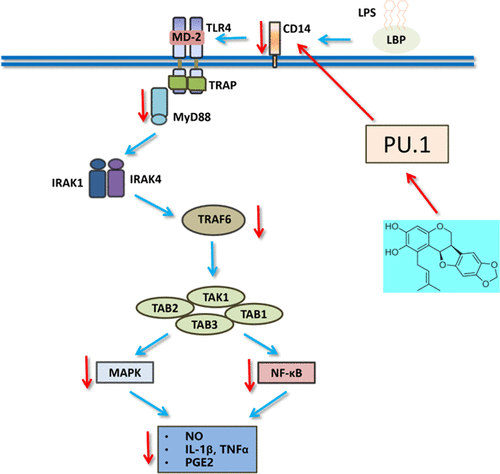当前位置:
X-MOL 学术
›
ACS Chem. Neurosci.
›
论文详情
Our official English website, www.x-mol.net, welcomes your feedback! (Note: you will need to create a separate account there.)
Discovery of a New Pterocarpan-Type Antineuroinflammatory Compound from Sophora tonkinensis through Suppression of the TLR4/NFκB/MAPK Signaling Pathway with PU.1 as a Potential Target.
ACS Chemical Neuroscience ( IF 5 ) Pub Date : 2018-09-28 , DOI: 10.1021/acschemneuro.8b00243 Wenjuan Xia 1 , Pan Luo 1 , Pei Hua 1 , Peng Ding 1 , Chanjuan Li 1 , Jun Xu 1 , Huihao Zhou 1 , Qiong Gu 1
ACS Chemical Neuroscience ( IF 5 ) Pub Date : 2018-09-28 , DOI: 10.1021/acschemneuro.8b00243 Wenjuan Xia 1 , Pan Luo 1 , Pei Hua 1 , Peng Ding 1 , Chanjuan Li 1 , Jun Xu 1 , Huihao Zhou 1 , Qiong Gu 1
Affiliation

|
Neuroinflammation underlies many neuro-degenerative diseases. In this paper, we report the identification of a new pterocarpan-type anti-inflammatory compound named sophotokin isolated from Sophora tonkinensis. S. tonkinensis has been used traditionally for treatment of conditions related to inflammation. Our initial screening showed that sophotokin dose-dependently inhibits lipopolysaccharide (LPS)-stimulated production of NO, TNF-α, PGE2, and IL-1β in microglial cells. This antineuroinflammatory effect was associated with sophotokin's blockade of LPS-induced production of the inflammatory mediators iNOS and COX-2. Western blot and qPCR analysis demonstrated that sophotokin inhibits both the p38-MAPK and NF-κB signal pathways. Further studies revealed that sophotokin also suppresses the expression of cluster differentiation 14 (CD14) in the toll-like receptor 4 (TLR4) signaling pathway. Following down-regulation of MyD88 and TRAF6, sophotokin inhibits the activation of the NF-κB and MAPK signal pathways in LPS-induced BV-2 cells. In silico studies suggested that sophotokin could interact with PU.1-DNA complex through hydrogen binding at sites 1 and 2 of the complex, blocking the DNA binding. This suggests that PU.1 may be a potential target of sophotokin. Taken together, these results suggest that sophotokin may have therapeutic potential for diseases related to neuroinflammation. The mechanism of antineuroinflammatory effects involves inhibition of the TLR4 signal pathway at the sites of NF-κB and MAPK with PU.1 as a likely upstream target.
中文翻译:

通过抑制以PU.1为潜在靶标的TLR4 /NFκB/ MAPK信号传导途径,从槐豆中发现一种新的翼果类抗神经炎化合物。
神经炎症是许多神经退行性疾病的基础。在本文中,我们报告了一种新的鉴定为从槐豆中分离出的翼果木型消炎化合物sophotokin的鉴定。传统上已经将S.tonkinensis用于治疗与炎症有关的病症。我们的初步筛选显示,光照相素剂量依赖性地抑制脂多糖(LPS)刺激的小胶质细胞中NO,TNF-α,PGE2和IL-1β的产生。这种抗神经炎作用与sophotokin对LPS诱导的炎性介质iNOS和COX-2产生的阻断有关。Western印迹和qPCR分析表明,光敏蛋白抑制p38-MAPK和NF-κB信号通路。进一步的研究表明,photophotokin还抑制通行费样受体4(TLR4)信号传导途径中的簇分化14(CD14)的表达。在MyD88和TRAF6下调后,光敏素抑制LPS诱导的BV-2细胞中NF-κB和MAPK信号通路的激活。在计算机研究中,研究表明光敏蛋白可以通过在复合位点1和2处的氢键与PU.1-DNA复合物相互作用,从而阻止DNA的结合。这表明PU.1可能是光敏蛋白的潜在靶标。综上所述,这些结果表明,光敏素可能具有与神经炎症相关的疾病的治疗潜力。抗神经炎作用的机制涉及以PU.1为可能的上游靶标抑制NF-κB和MAPK部位的TLR4信号通路。
更新日期:2018-09-17
中文翻译:

通过抑制以PU.1为潜在靶标的TLR4 /NFκB/ MAPK信号传导途径,从槐豆中发现一种新的翼果类抗神经炎化合物。
神经炎症是许多神经退行性疾病的基础。在本文中,我们报告了一种新的鉴定为从槐豆中分离出的翼果木型消炎化合物sophotokin的鉴定。传统上已经将S.tonkinensis用于治疗与炎症有关的病症。我们的初步筛选显示,光照相素剂量依赖性地抑制脂多糖(LPS)刺激的小胶质细胞中NO,TNF-α,PGE2和IL-1β的产生。这种抗神经炎作用与sophotokin对LPS诱导的炎性介质iNOS和COX-2产生的阻断有关。Western印迹和qPCR分析表明,光敏蛋白抑制p38-MAPK和NF-κB信号通路。进一步的研究表明,photophotokin还抑制通行费样受体4(TLR4)信号传导途径中的簇分化14(CD14)的表达。在MyD88和TRAF6下调后,光敏素抑制LPS诱导的BV-2细胞中NF-κB和MAPK信号通路的激活。在计算机研究中,研究表明光敏蛋白可以通过在复合位点1和2处的氢键与PU.1-DNA复合物相互作用,从而阻止DNA的结合。这表明PU.1可能是光敏蛋白的潜在靶标。综上所述,这些结果表明,光敏素可能具有与神经炎症相关的疾病的治疗潜力。抗神经炎作用的机制涉及以PU.1为可能的上游靶标抑制NF-κB和MAPK部位的TLR4信号通路。



























 京公网安备 11010802027423号
京公网安备 11010802027423号